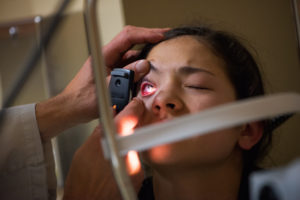By Mark K. Davis, OD

May 17, 2023
After selling my multi-office practice in San Antonio, Texas, I did not want to retire from optometry, the profession I love. I decided to work part-time, doing relief work across the state of Texas (think big state). This allowed me to see firsthand the coding and billing practices of my fellow optometrists. All shall remain anonymous and no mistakes made were, in my opinion, malicious or intentional in nature.
I was working for an optometrist in west Texas who went on vacation. This practice was deep in the Permian Basin of Texas. Think oil, black gold, Texas tea (Beverly Hillbillies). I set my personal record for corneal foreign body removals. Seven individuals, some with multiple metal foreign bodies in the eye. After the third patient I quit asking if they had been wearing their safety glasses. All responses were “yes,” and that the metal had ricocheted.
After having the patient sign an Informed Consent, I followed the standard protocol for foreign body removal and bandage contact lens application. The patient was scheduled for a 24-hour follow-up visit and then dismissed. I coded the procedure simply as 65222-RT or LT, depending on which eye, corneal foreign body removal, with slit lamp. Nothing more.
The optometric assistant asked me why I did not charge for the office visit or a bandage contact lens. And what about the patient who had two metal foreign bodies in one eye? I explained to her as follows:
“Medicare has what is called National Correct Coding Initiative (NCCI) edits. In a nutshell, it says what codes may NOT be billed together. They are called Procedure to Procedure (PTP) code pair edits. Each carrier for Medicare has a NCCI PTP lookup tool. Our carrier in Texas is Novitas Solutions. I will use that for example.”
If you click HERE and input CPT code 65222 and your date of service, a chart will come up with several columns. Column one is the procedure that you are searching for and column two are the procedures that are NOT allowed to be billed on the same day. Column three is the effective date the two procedures were disallowed. Column four indicates if a modifier may be used, with documentation that supports medical necessity for both services performed on the same date of service and same provider.
Scroll through the list and note that an office visit (either 92XXX or 99XXX) or the application of bandage contact lens (92071) is not allowed unless an appropriate modifier is used PLUS additional documentation. More on modifiers in future columns. Also by definition the global surgical package includes one office visit either the day before or day of surgery, as defined in the CPT manual.

If you would like more information on NCCI edits, click HERE for the CMS booklet.
It has been my experience that anytime you use multiple modifiers and need to submit additional documentation, that your claim takes longer to be paid and that you make yourself more subject to audits. Each doctor can make their own choice. I like to keep it simple.
Concerning the patient who had more than one metal foreign body in one eye, the CPT code 65222 is “per eye,” no matter how many foreign bodies you remove.
Other Articles to Explore
At the 24-hour follow-up, I did charge for an office visit (92012), as CPT 65222 has a zero days global fee period. If the cornea was not totally healed, and I needed to apply another bandage contact lens (92071), I could definitely charge for that. You cannot charge for the bandage contact lens if you use a trial lens from your fitting set (most doctors do this, I believe).
What about the case of a corneal abrasion (ICD-10, S05.01XA – initial encounter)? In this case, you can definitely charge for an office visit and the application of a bandage contact lens.
I hope this has been helpful and I look forward to offering more coding tips in future articles.
 Mark K. Davis, OD, is a Therapeutic Optometrist and Optometric Glaucoma Specialist, Diplomate, American Board of Optometry, Adjunct Assistant Professor, University of Houston College of Optometry and Chief of Optometry, 147th Medical Group. He is Lt Col, Texas Air National Guard, Ellington Field JRB, Houston, Texas.
Mark K. Davis, OD, is a Therapeutic Optometrist and Optometric Glaucoma Specialist, Diplomate, American Board of Optometry, Adjunct Assistant Professor, University of Houston College of Optometry and Chief of Optometry, 147th Medical Group. He is Lt Col, Texas Air National Guard, Ellington Field JRB, Houston, Texas.

























